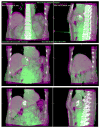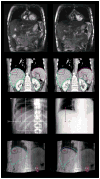Adaptive management of liver cancer radiotherapy
- PMID: 20219548
- PMCID: PMC2856079
- DOI: 10.1016/j.semradonc.2009.11.004
Adaptive management of liver cancer radiotherapy
Abstract
Adaptive radiation therapy for liver cancer has the potential to reduce normal tissue complications and enable dose escalation, allowing the potential for tumor control in this challenging site. Using adaptive techniques to tailor treatment margins to reflect patient-specific breathing motions and image-guidance techniques can reduce the high dose delivered to surrounding normal tissues while ensuring that the prescription dose is delivered to the tumor. Several treatment planning and delivery techniques have been developed for use in the liver, including a margin to encompass the full breathing motion, mean position techniques, which evaluate the probability of tumor location during breathing, breath hold, gating, and tracking. Patient selection, clinical workflow, and quality assurance must be considered and developed before integrating these techniques into clinical practice.
Copyright 2010 Elsevier Inc. All rights reserved.
Figures




Similar articles
-
Adaptive management of bladder cancer radiotherapy.Semin Radiat Oncol. 2010 Apr;20(2):116-20. doi: 10.1016/j.semradonc.2009.11.005. Semin Radiat Oncol. 2010. PMID: 20219549 Review.
-
Adaptive radiation therapy for prostate cancer.Semin Radiat Oncol. 2010 Apr;20(2):130-7. doi: 10.1016/j.semradonc.2009.11.007. Semin Radiat Oncol. 2010. PMID: 20219551 Free PMC article. Review.
-
Deep Inspiration Breath Hold-Based Radiation Therapy: A Clinical Review.Int J Radiat Oncol Biol Phys. 2016 Mar 1;94(3):478-92. doi: 10.1016/j.ijrobp.2015.11.049. Epub 2015 Dec 17. Int J Radiat Oncol Biol Phys. 2016. PMID: 26867877 Review.
-
Adaptive radiotherapy: merging principle into clinical practice.Semin Radiat Oncol. 2010 Apr;20(2):79-83. doi: 10.1016/j.semradonc.2009.11.001. Semin Radiat Oncol. 2010. PMID: 20219545 No abstract available.
-
Assessment of setup uncertainty in hypofractionated liver radiation therapy with a breath-hold technique using automatic image registration-based image guidance.Radiat Oncol. 2019 Aug 30;14(1):154. doi: 10.1186/s13014-019-1361-6. Radiat Oncol. 2019. PMID: 31470860 Free PMC article.
Cited by
-
Long-Term Clinical Results of MR-Guided Stereotactic Body Radiotherapy of Liver Metastases.Cancers (Basel). 2023 May 17;15(10):2786. doi: 10.3390/cancers15102786. Cancers (Basel). 2023. PMID: 37345123 Free PMC article.
-
Feasibility of Four-dimensional Adaptation of Volumetric Modulated Arc Therapy Based on Volumetric Modulated Arc Therapy-computed Tomography.J Med Phys. 2023 Apr-Jun;48(2):154-160. doi: 10.4103/jmp.jmp_24_23. Epub 2023 Jun 29. J Med Phys. 2023. PMID: 37576092 Free PMC article.
-
Magnetic Resonance-Guided Stereotactic Body Radiotherapy of Liver Tumors: Initial Clinical Experience and Patient-Reported Outcomes.Front Oncol. 2021 Jun 9;11:610637. doi: 10.3389/fonc.2021.610637. eCollection 2021. Front Oncol. 2021. PMID: 34178616 Free PMC article.
-
Radiotherapy planning using MRI.Phys Med Biol. 2015 Nov 21;60(22):R323-61. doi: 10.1088/0031-9155/60/22/R323. Epub 2015 Oct 28. Phys Med Biol. 2015. PMID: 26509844 Free PMC article.
-
Real-time, volumetric imaging of radiation dose delivery deep into the liver during cancer treatment.Nat Biotechnol. 2023 Aug;41(8):1160-1167. doi: 10.1038/s41587-022-01593-8. Epub 2023 Jan 2. Nat Biotechnol. 2023. PMID: 36593414 Free PMC article.
References
-
- Parkin DM, Bray F, Ferlay J, Pisani P. Global cancer statistics, 2002. CA Cancer J Clin. 2005;55(2):74–108. - PubMed
-
- Jemal A, Siegel R, Ward E, Hao Y, Xu J, Murray T, Thun MJ. Cancer statistics, 2008. CA Cancer J Clin. 2008;58(2):71–96. - PubMed
-
- Cummings LC, Payes JD, Cooper GS. Survival after hepatic resection in metastatic colorectal cancer: a population-based study. Cancer. 2007 Feb 15;109(4):718–726. - PubMed
-
- Liu JH, Chen PW, Asch SM, Busuttil RW, Ko CY. Surgery for hepatocellular carcinoma: does it improve survival? Ann Surg Oncol. 2004;11(3):298–303. - PubMed
-
- Kuvshinoff BW, Ota DM. Radiofrequency ablation of liver tumors: influence of technique and tumor size. Surgery. 2002;132(4):605–611. - PubMed
Publication types
MeSH terms
Grants and funding
LinkOut - more resources
Full Text Sources
Medical

